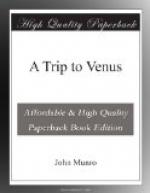“Higher still is the ‘corona,’ an aureole of silvery beams visible in a total eclipse, and resembling the star of a decoration. The streamers have been traced for hundreds of thousands of miles beyond the solar disc. It appears to consist of meteoric stones, illuminated by the sunlight as well as of incandescent vapours of ‘coronium,’ a very light element unknown on the earth, and probably, too, of electrical discharges. The ‘zodiacal light,’ that silvery glow often seen in the west after sunset, or in the east before sunrise, may be a prolongation of it.”
“I daresay these meteorites are swarming about the sun like midges about a lamp,” said I.
“And just as eager to get burnt up,” replied Gazen, with a smile. “Let us pass now to the planets. The little one next the sun is Mercury, who can be seen as a rosy-white star soon after sunset or before sunrise. He is about 36 million miles, more or less, from the sun; travels round his orbit in 88 days, the length of his year; and spins about his axis in 24 hours, making a day and night. His diameter is 3,000 miles, and his mass is nearly seven times that of an equal volume of water. The attraction of gravity on his surface is barely half that on the earth, and a man would feel very light there. Mercury seems to have a dense atmosphere, and probably high mountains, if not active volcanoes. The sunshine is from four to nine times stronger there than on the earth, and as summer and winter follow each other in six weeks, he is doubtless rather warm.
“Venus, the ‘Shepherd’s Star,’ and the brightest object in the heavens after the moon, can sometimes be seen by day, and casts a distinct shadow at night. She is about 67 million miles from the sun, revolves round him in 225 days, and rotates on her axis in 23 to 24 hours, or as Schiaparelli believes, in 224 days. Her diameter is 7,600 miles, and her mass nearly five times that of an equal volume of water. Gravity is rather less there than it is here. Like Mercury, she appears to have a cloudy atmosphere, and very high mountains. On the whole she resembles the earth, but is, perhaps, a younger as well as a warmer planet.




